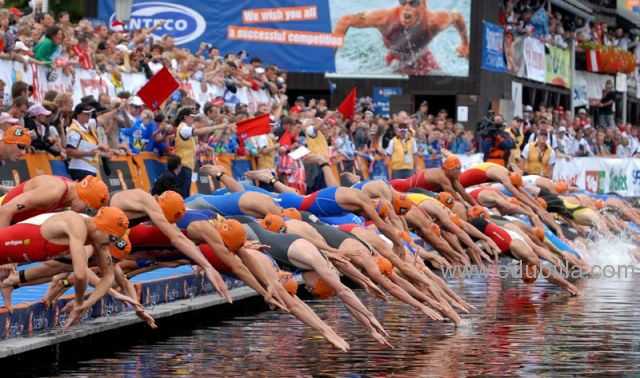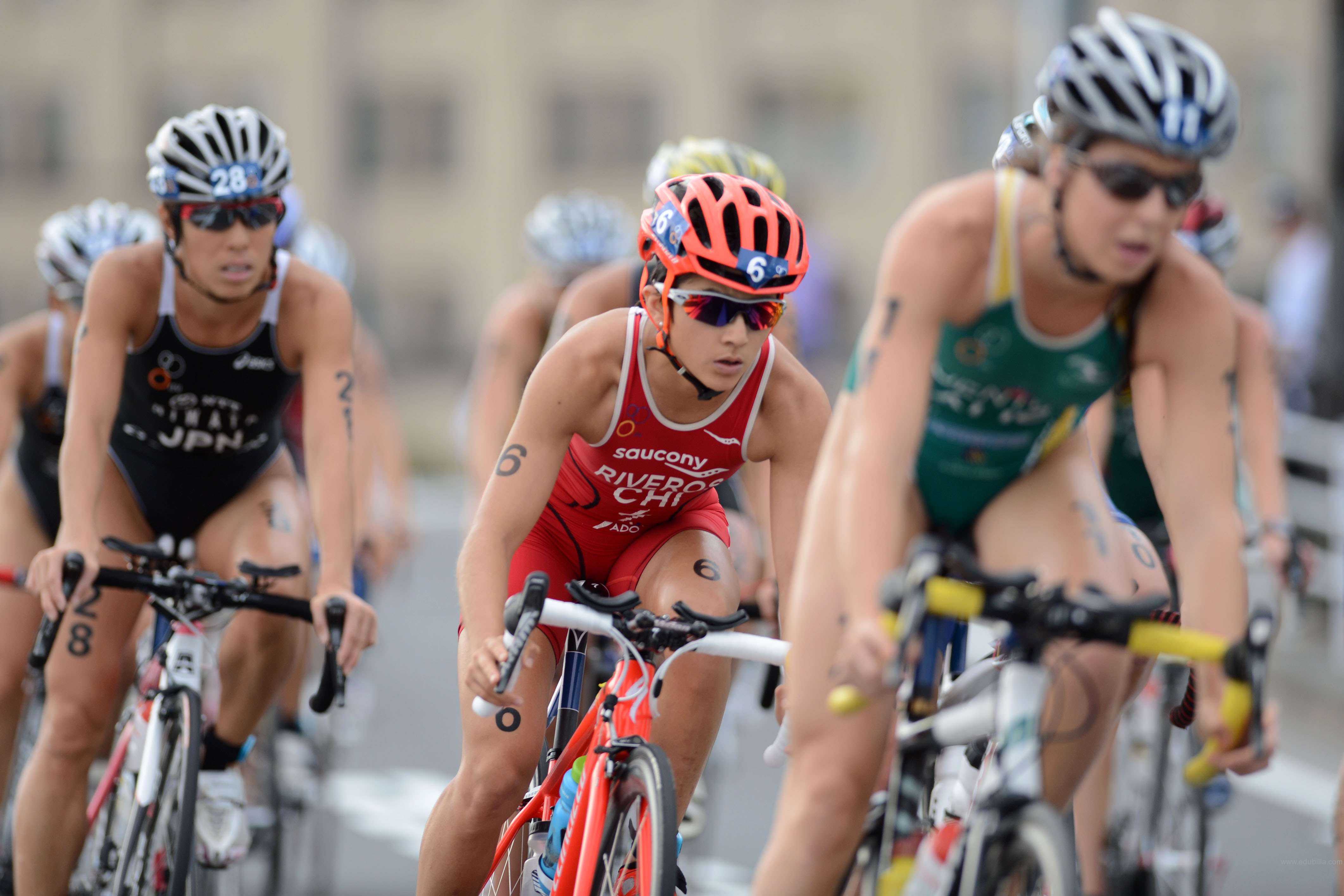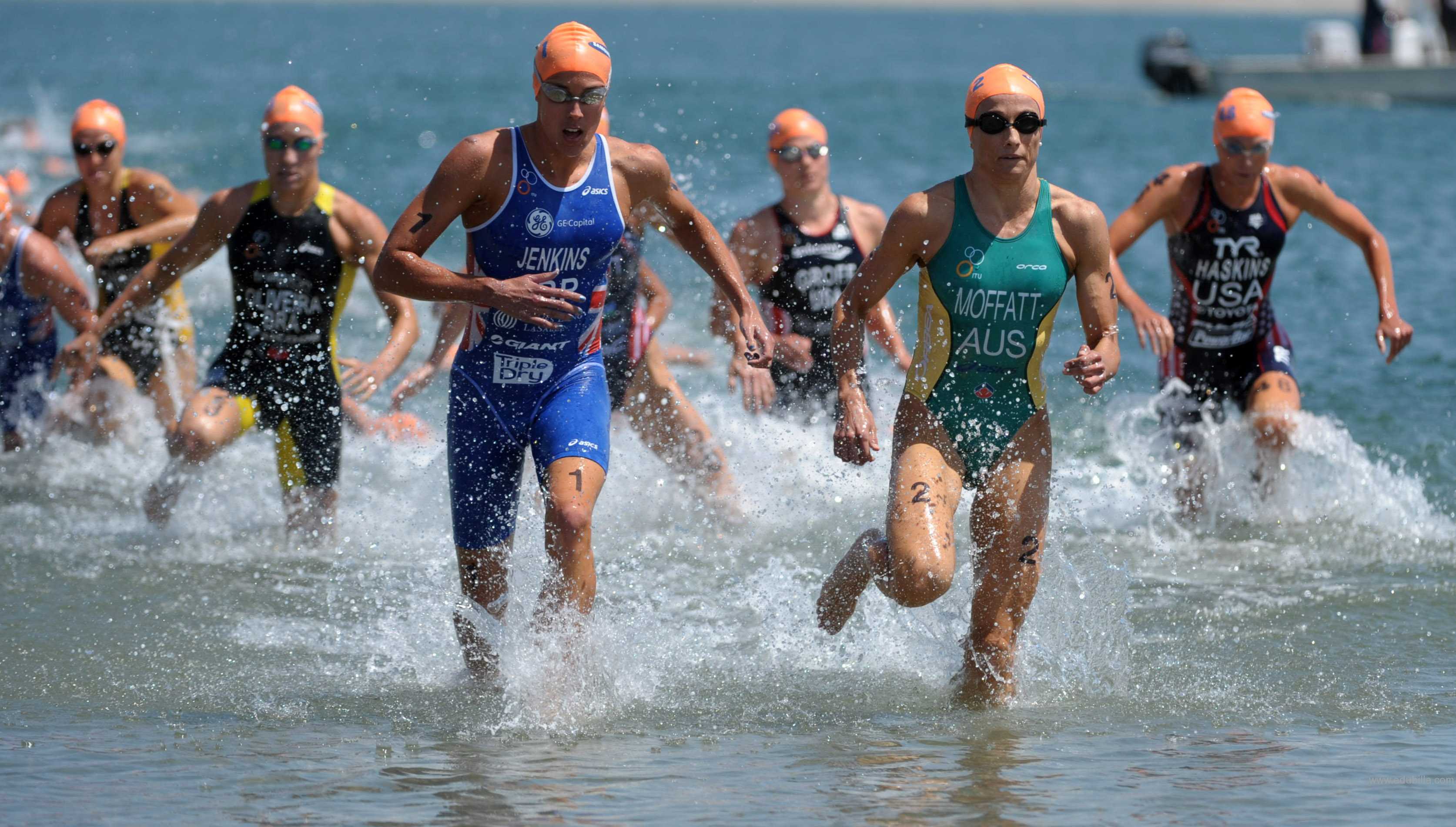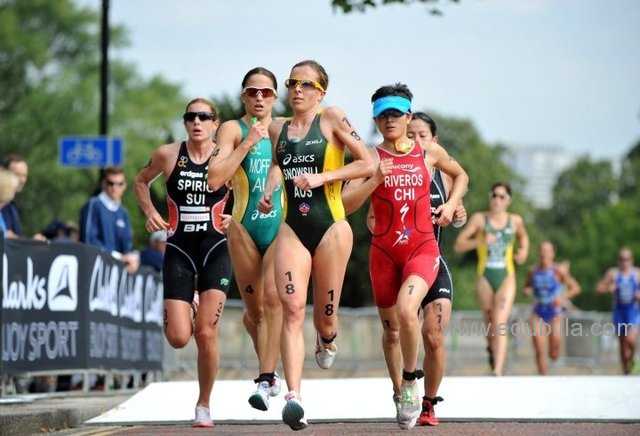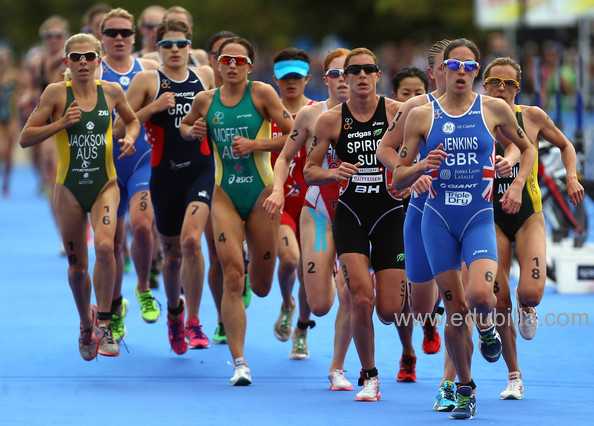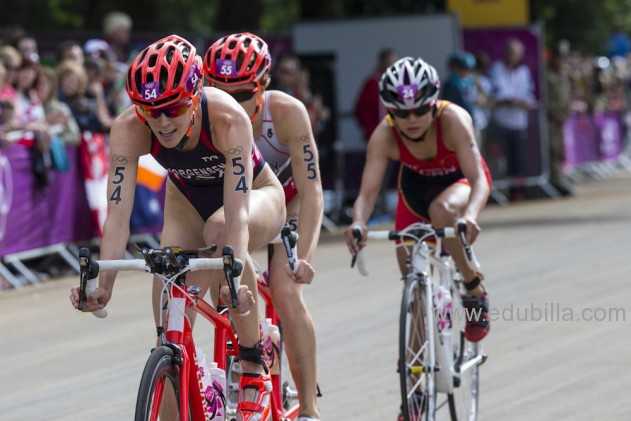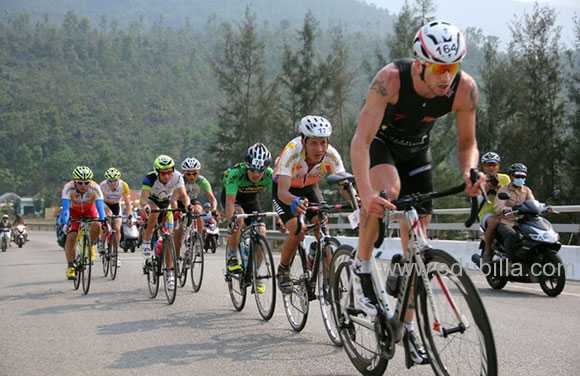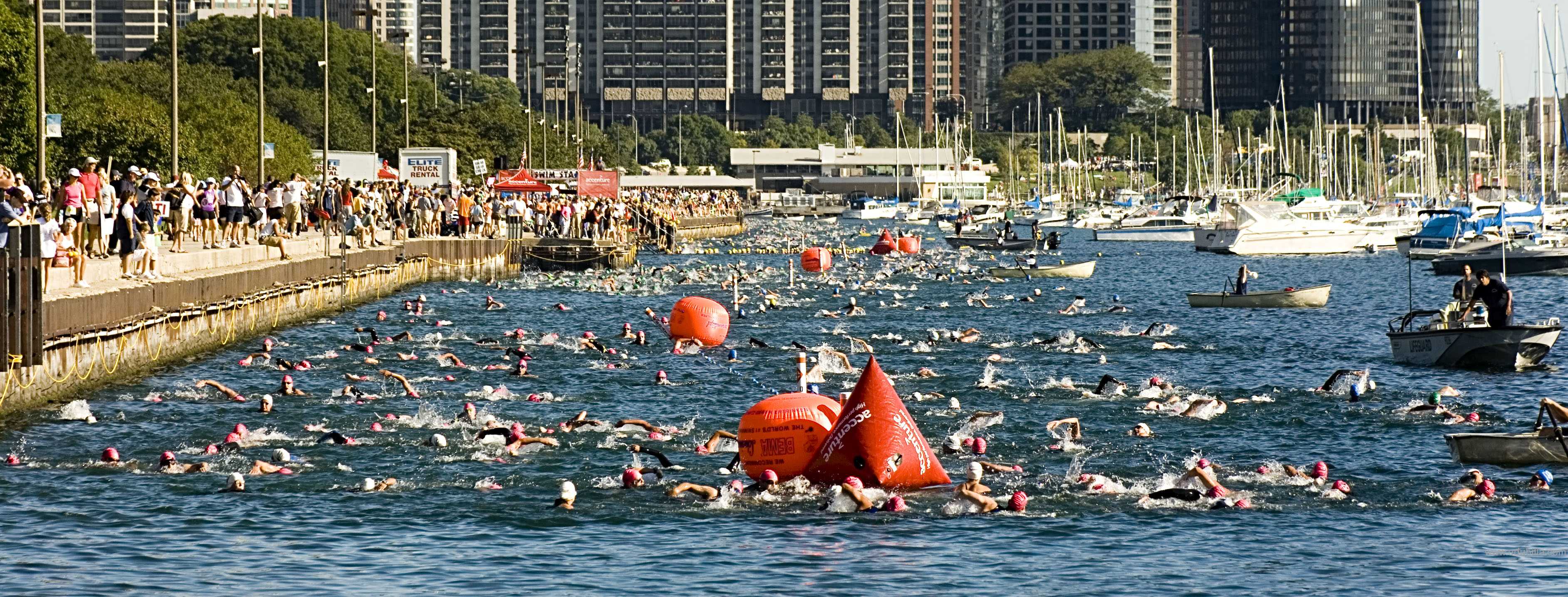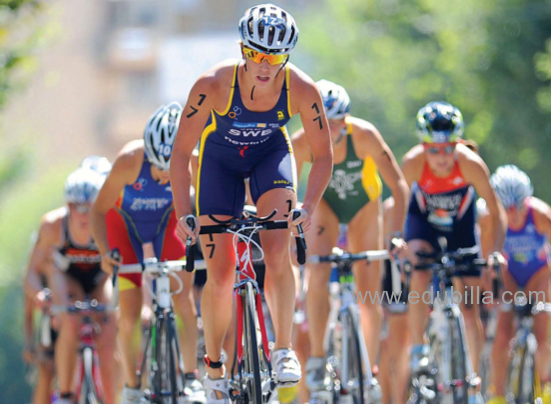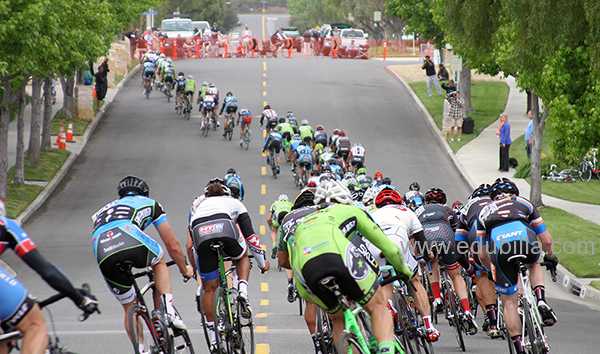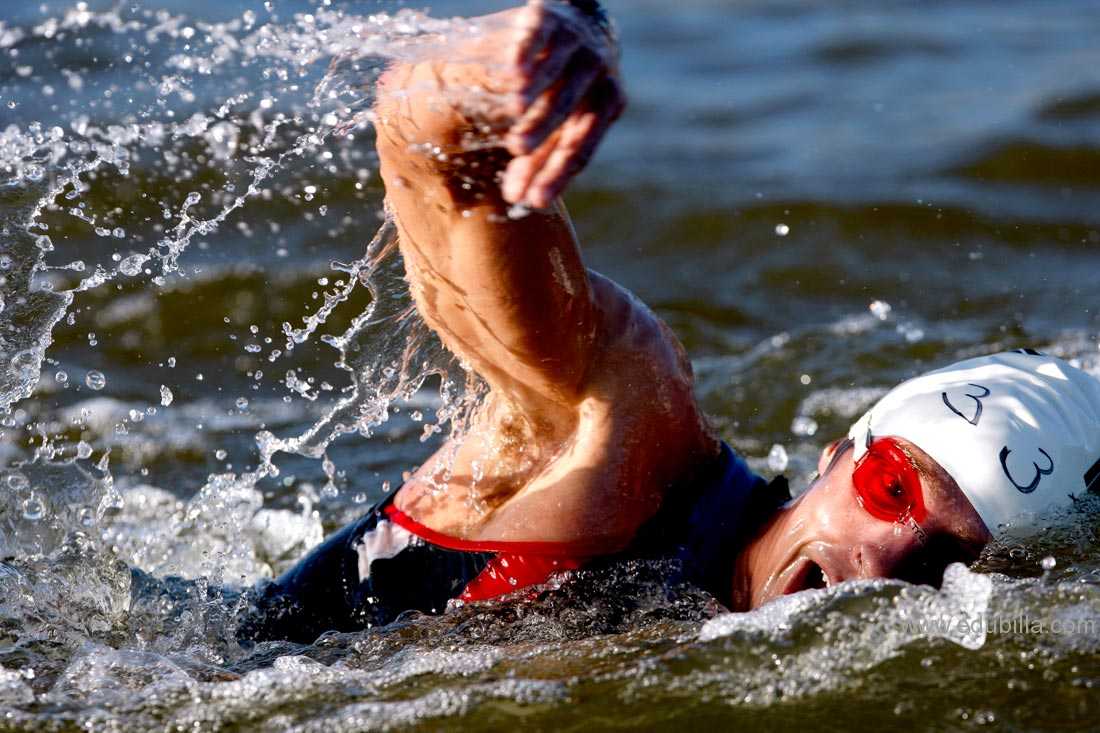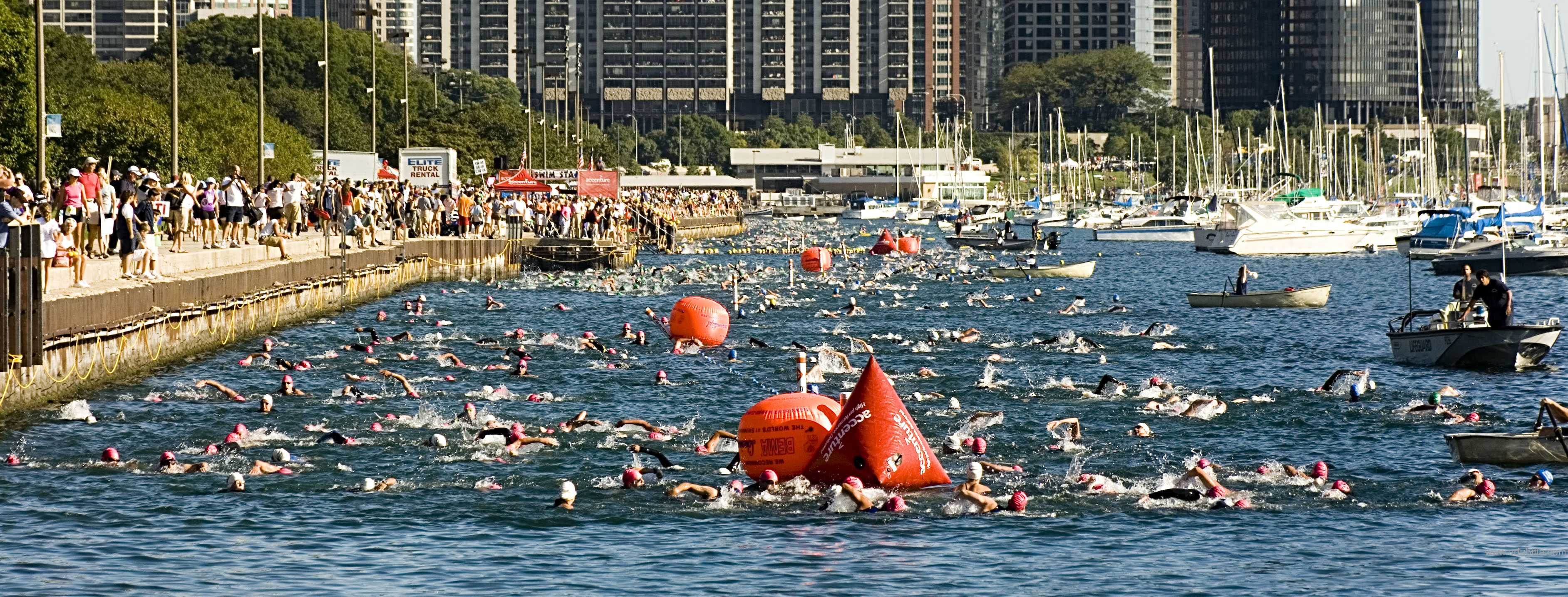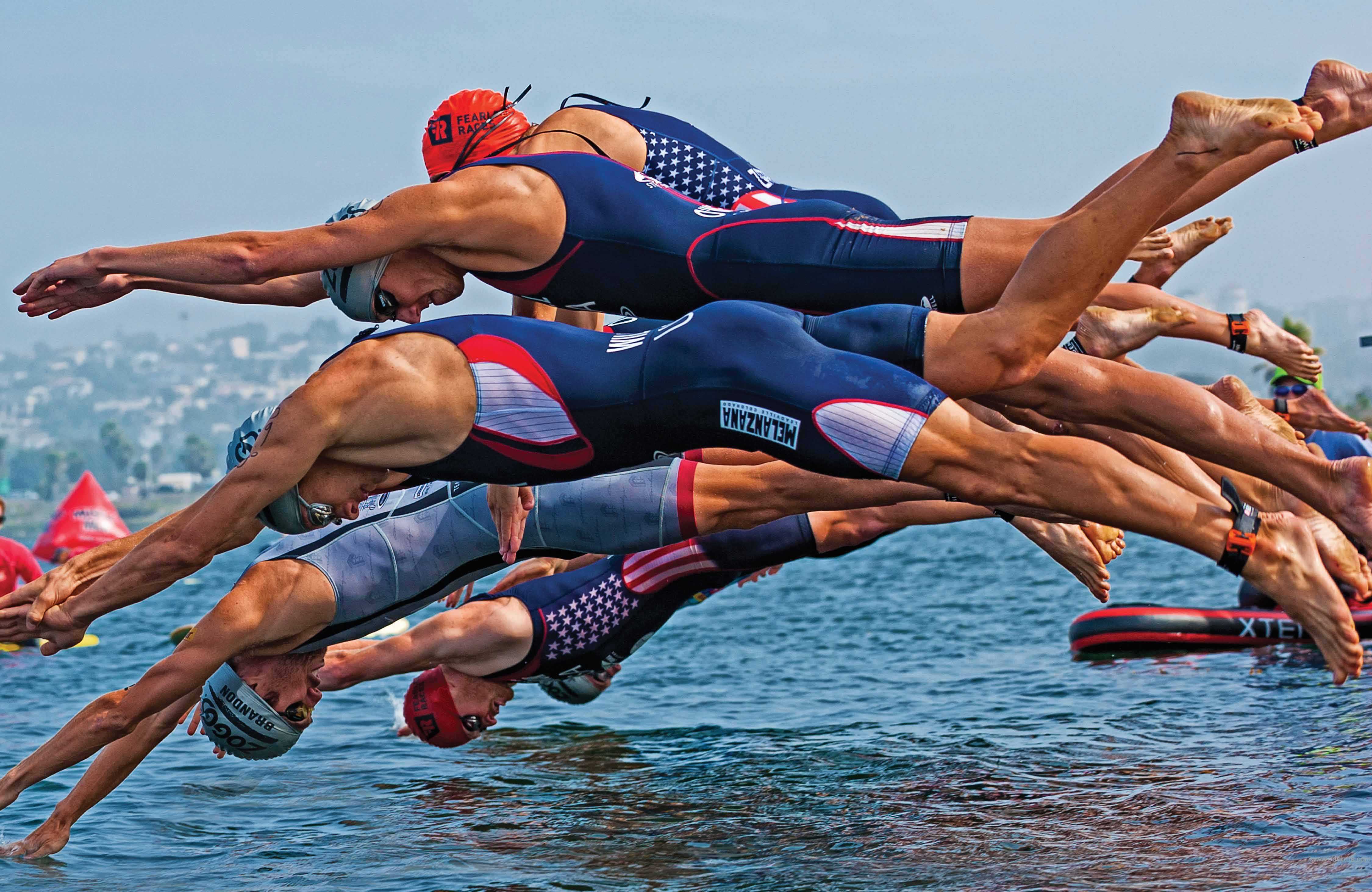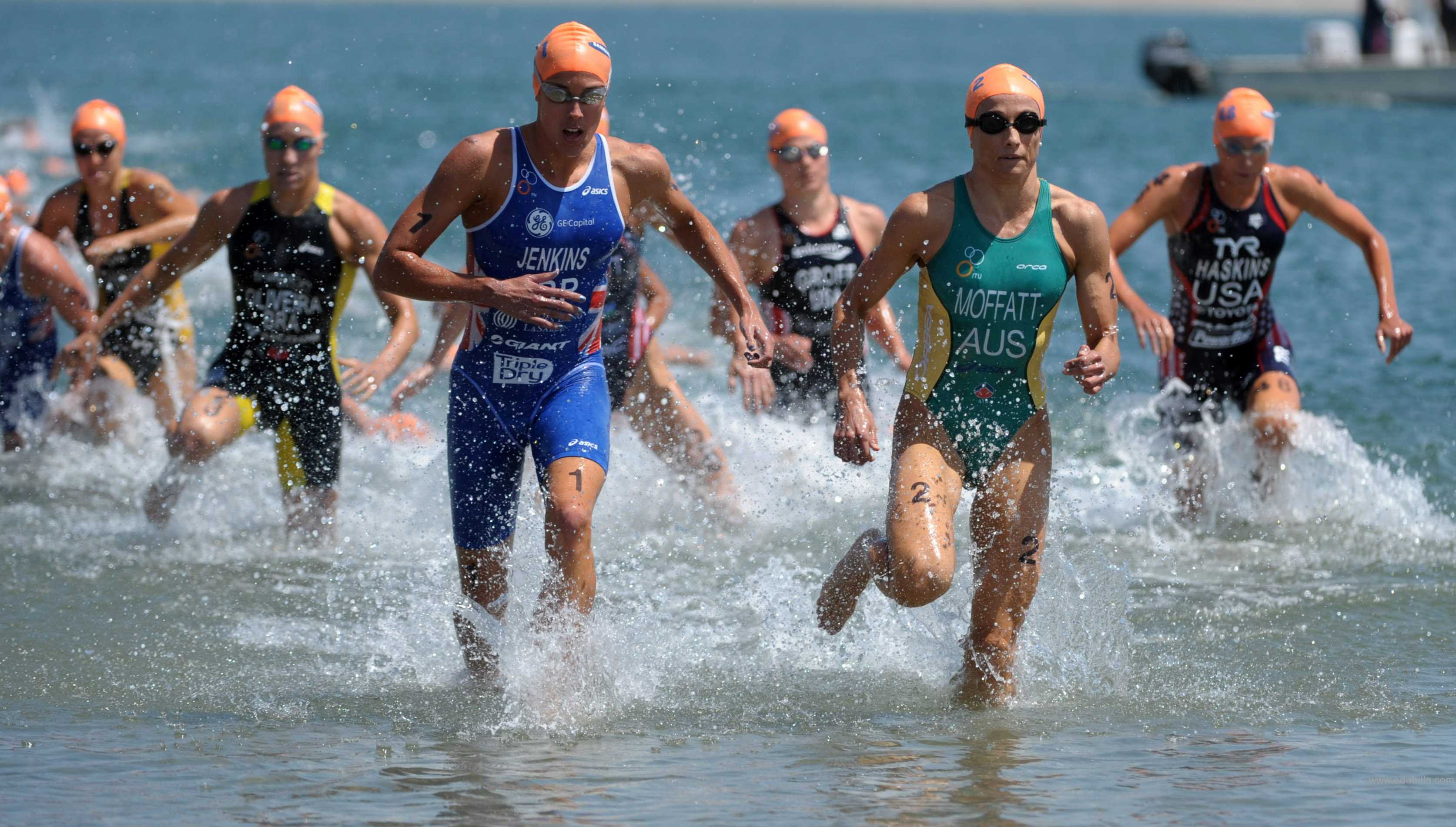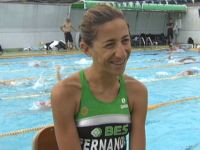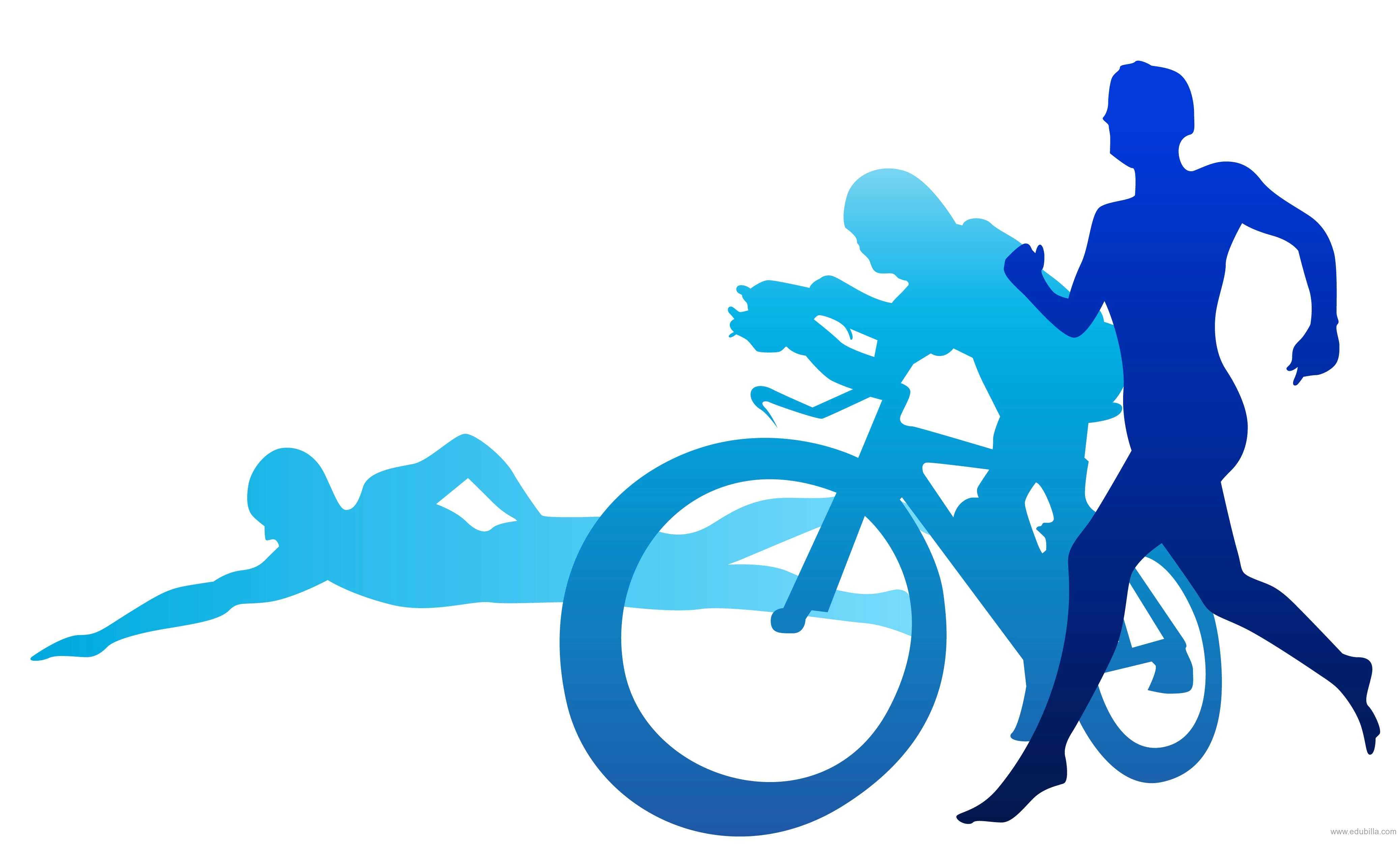
Overview Of Triathlon
A triathlon is a multiple-stage competition involving the completion of three continuous and sequential endurance disciplines.While many variations of the sport exist, triathlon, in its most popular form, involves swimming, cycling, and running in immediate succession over various distances. Triathletes compete for fastest overall course completion time, including timed "transitions" between the individual swim, cycle, and run components.The word "triathlon" is of Greek origin from or treis ("three") and or athlos ("contest").
Triathlon races vary in distance. According to the International Triathlon Union, and USA Triathlon, the main international race distances are:
Sprint Distance; 750-meter (0.47-mile) swim, 20-kilometer (12-mile) bike, 5-kilometer (3.1-mile) run
Intermediate (or Standard) distance; commonly referred to as the "Olympic distance": 1.5-kilometer (0.93-mile) swim, 40-kilometer (25-mile) bike, 10-kilometer (6.2-mile) run
Long Course;1.9-kilometer (1.2-mile) swim, 90-kilometer (56-mile) bike, and a 21.1-kilometer (13.1-mile) run (half marathon)
ITU Long Distance;4-kilometer (2.5-mile) swim, 120-kilometer (75-mile) bike, and a 30-kilometer (19-mile) run
Ultra Distance; commonly referred to as 140.6 (total distance in miles, equivalent to 226.2 km) or the 'Ironman'; 3.8-kilometer (2.4-mile) swim, 180.2-kilometer (112.0-mile) bike, and a 42.2-kilometer (26.2-mile) run (full marathon)
Ironman Triathlon:
The most recognized branded Ultra Distance is the Ironman triathlon.A transition area is set up where the athletes change gear for different segments of the race. This is where the switches from swimming to cycling and cycling to running occur. These areas are used to store bicycles, performance apparel, and any other accessories needed for the next stage of the race. The transition from swim and bike is referred to as T1 and that between the bike and run is referred to as T2. The athlete's overall time for the race includes time spent in T1 and T2.Transitions areas vary in size depending on the number of participants expected. In addition, these areas provide a social headquarters before the race.
Modern triathlon:
The first modern swim/bike/run event to be called a 'triathlon' was held at Mission Bay, San Diego, California on September 25, 1974. The race was conceived and directed by Jack Johnstone and Don Shanahan, members of the San Diego Track Club, and was sponsored by the track club. 46 participants entered this event. It was reportedly not inspired by the French events,although a race the following year at Fiesta Island, San Diego, California, is sometimes called 'the first triathlon in America.
Game Rules
BASIC TRIATHLON RULES
While we encourage everyone to read (and obey!) the full ITU Rules, the basic rules below are a good place to start:
GENERAL:
- No headphones in any part of the race.
- No glass containers can be used at any time during competition.
- If a race number is provided, you must wear it so that it is visible on the front during the run. You must not alter it in anyway.
- You must not receive assistance of any kind other than the help provided by the race organizers. It is the athlete’s responsibility to know the course at all times. You may leave the course at any time, but must re-enter the course at the same location. Race directors are required to provide you with maps prior to the event. Know the course.
SWIM:
- You may use any stroke, tread water, float, stand or rest on an inanimate object at any time. You may not use the bottom or other objects to move forward.
- You cannot wear fins or snorkels, but may wear a wetsuit if it falls within specified guidelines.
BIKE:
- You must obey the rules of the road unless directed by police/RCMP or a certified official. This includes riding as far right as is possible, stopping at stop signs and obeying traffic lights. In addition, do not cross the centerline of the road at any time.
- Helmets must be fastened at all times while you are in possession of your bike. (Don’t take your bike off the rack until your helmet is fastened; don’t undo your helmet until you’ve put your bike back.) Your helmet must also be worn any time you are on your bike at the race site, even during warm up or riding to the race.
- You cannot follow within 10m (30ft) of another bike (drafting) and may not ride within 1.5m (5ft) to the side of another bike (blocking). You may break these rules only to pass and have a maximum of 15 seconds to enter the 10m/1.5m zone and complete the pass on the left and be out of the 10m zone. The cyclist who has been passed (or a person who attempted and failed a pass) must immediately drop out of the draft zone before they attempt the pass again.
RUN:
You can run or walk, but they don’t let you crawl.
TRANSITION:
You must rack your bike in a designated space. Be aware that you will have a limited amount of space for personal effects. Officials will normally point this out during the briefing.
Bikes cannot be ridden in transition and you will be instructed to mount and dismount your bike at a designated location known as the mount/dismount line.
If you break a rule at any point during the event, an official will blow a whistle, say your race number and ask you to safely come to a stop for further instructions. When you oblige, the official may:
- Give a verbal warning and/or penalty;
- Give you a warning/penalty and a time penalty to be served on the spot;
- Give you a warning/penalty and a time penalty to be added to your final time;
- Give you a disqualification and remove you from further competition;
- Give you a disqualification and allow you to continue to race pending your ability to appeal the disqualification; or
- Remove you from the competition for medical/safety reasons.
You have the right to appeal or protest the ruling. You may also protest things like the course and another competitor’s conduct. There are time limits and protocol to follow, but you do have rights and should know them.
Each race has a pre-race briefing and this is an excellent time to hear the rules and special rules that may apply on the day. When in doubt, ask an official for clarification. If you really want to know your stuff, Triathlon Nova Scotia offers several level 1 & 2 officials clinics each year.
Detailed Triathlon Rules Can Be Downloaded From Documents
Equipments Need For Triathlon
Bicycle:
Used in the cycling section of the sport.
Bike rack:
The device that holds bicycles in an upright position in the transition area.
Bottom bracket:
A hole in the base of a bicycle frame where the axle unit is attached.
Chainring:
A large toothed ring within the chainset of a bicycle that drives the chain via the pedals and cranks.
Chainset:
The chainwheels, chain and rear sprocket, as one, on a bicycle.
Crank:
An arm, bolted to the crankshaft, which drives the chainwheels on a bicycle.
Crankshaft:
The axle to which the cranks are attached on a bicycle.
Derailleur:
The mechanism which moves the chain from one chainring or sprocket to another on a bicycle.
Goggles:
Enclosed eyewear which prevent water from getting into a swimmer's eyes.
Nose clip:
A clip which prevents water from getting into a swimmer's nose.
Pontoon:
The floating apparatus from which triathletes dive to start the swimming leg.
Shoes:
Sprocket:
1. one of a series of teeth or projections on a wheel for transmitting or receiving motion to or from a corresponding tooth or part on a bicycle; also called a "cog".
2. a sprocket wheel; also called a "cogwheel".
Sprocket wheel:
A wheel with sprockets; also called a "cogwheel".
Swim buoy:
A marker used as a turning point in the swimming course.
Swimming cap:
A lightweight, head-hugging and flexible cap which holds the hair in place and reduces resistance when swimming.
Wetsuit:
A tight-fitting rubber suit worn to keep a swimmer warm and increase buoyancy.
History Of Triathlon
Triathlon was invented as an alternative workout to track training in the 1970s, and made its Olympic debut at the 2000 Sydney Games.
Alternative workout:
Triathlon was invented in the early 1970s by the San Diego Track Club, as an alternative workout to the rigours of track training. The club's first event consisted of a 10km run, an 8km cycle and a 500m swim. Over the next decade, triathlon’s popularity continued to build, and it soon gained worldwide recognition.
First World Championships:
In 1989, the International Triathlon Union (ITU) was founded in Avignon, France, and the first official World Championships were held. The official distance for triathlon was set at a 1,500m swim, a 40km cycle and a 10km run – taken from existing events in each discipline already on the Olympic programme.
World cup circuit:
In 1991, the ITU launched its first full season of the World Cup circuit. Twelve races were contested in nine different countries. More World Cup races have subsequently been added every year as the sport’s appeal continues to grow.
Olympic debut:
Triathlon made its Olympic full medal debut at the 2000 Sydney Games. This helped the sport to become even more popular. It now has over 120 affiliated national federations around the world.
Origin Of Triathlon
A “triathlon” is defined as a three-part sports discipline comprising swimming, cycling, and running. The three sports are contested as a continuous event without a rest. The triathlon can be an individual or team event over varying distances.
First Triathlon Event:
Triathlon history dates back to the early 1970s and originated with the San Diego Track Club. The triathlon was designed to be an alternative to hard track training. The first triathlon event was held on September 25, 1974. Don Shanahan and Jack Johnstone are pioneers in the history of the triathlon. The San Diego Track Club sponsored the event.
Triathlons in America:
Triathlons in America can be traced to Southern California in the 1970s. The first Mission Bay Triathlon was held on September 25, 1974 in San Diego. This is the date that most hold to be the official “birthday” of the modern triathlon. There were 46 people that showed up to compete in the multisport event consisting of a 500-yard swim, a 5-mile bike ride, and a 6-mile run.
Beginning of the Ironman:
As the sport started to catch on more and more, the beginnings of the most famous triathlon in the world began to unfold in Hawaii. Three separate events – the Waikiki Rough Water Swim (2.4 miles), The Oahu Bike Race (112 miles) and The Honolulu Marathon (26.2 miles) – were combined in 1978 to form the Hawaii Ironman Triathlon. Of the 15 competitors who started the race, only 12 of them crossed the finish line. By the early 1982, ABC’s Wide World of Sports was broadcasting the Hawaii Ironman and nearly 600 people entered the race. That number ballooned to nearly 3000 in 2006.
Rules Committees:
As triathlon continued to grow in popularity, official rules committees began to form. Today, there are multiple governing bodies for the sport of triathlon, each sanctioning and supporting different length races. The most prominent of which are USA Triathlon (USAT), The International Triathlon Union (ITU), and the World Triathlon Corporation (WTC), which licenses the Ironman series of races.
Governing Bodies
International Triathlon Union (ITU):
The International Triathlon Union (ITU) is the international governing body for the multi-sport disciplines of triathlon, duathlon, aquathlon and other nonstandard variations.ITU, which is headquartered in Lausanne, Switzerland, sanctions the ITU World Triathlon Series and the ITU Triathlon World Cup.

The ITU was formed in 1989, and organizes official world championship series races for the sport of triathlon. It was formed in part to give the growing sport of triathlon an official organizing body and in part to advocate for the entry of triathlon into the Olympic games.
ITU race series:
The primary ITU race series is the short-course or standard distance World Triathlon Series and Triathlon World Cup. The distances for the ITU world cup races are 1500 m swim, 40 km bike, and 10 km run. They were chosen from existing swim, bike, and run distances already in the Olympic games. This distance of triathlon has become one of the primary standards in the wor of triathlon.
Ironman Triathlon races:
More recently, the ITU created a long distance race circuit with official world championships. Long Distance Triathlon races are very similar in length to Ironman Triathlon races owned and organized by the World Triathlon Corporation.
International structure:
The ITU is structured into 5 continental regions, through which the national federations (the governing body of triathlon in each country) is affiliated to the ITU. Each of the continental regions offers a Continental Championship and Continental Cup Series.
Africa: African Triathlon Union (ATU) – 10 national federations
Americas: Pan American Triathlon Confederation (PATCO) – 36 national federations
Asia: Asian Triathlon Confederation (ASTC) – 22 national federations
Europe: European Triathlon Union (ETU) – 43 national federations
Oceania: Oceania Triathlon Union (OTU) – 8 national federations
Championships:
The world championship events organised by the ITU include:
- ITU World Triathlon Series
- ITU Team Triathlon World Championships
- ITU Long Distance Triathlon World Championships
- ITU Triathlon World Cup Series
- ITU Aquathlon World Championships
- ITU Duathlon World Championships
- ITU Winter Triathlon World Championships
- ITU Cross Triathlon World Championships
To Visit ITU Click Here.
Awards Related To Triathlon
220 Triathlon Awards:
Twenty categories are:
- Elite male triathlete of the year
- Club of the year
- Elite female triathlete of the year
- Race of the year (under 500 entries)
- Duathlete of the year
- Race of the year (over 500 entries)
- Men's age-grouper of the year
- Triathlon wetsuit brand of the year
- Women's age-grouper of the year
- Bike brand of the year
- Male paratriathlete of the year
- Shoe brand of the year
- Female paratriathlete of the year
- Innovative product of the year
- Youth triathlete of the year
- Triathlon retailer of the year
- International triathlete of the year
- Online retailer of the year
- Coach of the year
- Outstanding contribution of the year
USA TRIATHLON MULTISPORT AWARDS:
There are six categories, representing the Multisport Lifestyles:
VOLUNTEER OF THE YEAR AWARD:
This award recognizes an individual or organization whose volunteer leadership in the multisport movement has been transformative and who has mobilized and unified athletes, programs and organizations that improve the events, youth or others affiliated with the sport.
JEFF JEWELL SPIRIT AWARD:
This award honors Jeff Jewell, a massage therapist for Team USA from 2001-2009, active triathlete and devoted USA Triathlon annual member. He lost his battle with brain cancer on November 15, 2010. He was one of life’s biggest cheerleaders and was an inspiration to everyone he met. The recipient of this award is someone who truly embodies the spirit of Jeff Jewell.
MILITARY SPORT AWARD:
This award recognizes the multisport successes achieved by the men and women of the US Armed Forces.
MOST INSPIRATIONAL COMEBACK AWARD:
This award recognizes athletes who have made a comeback to the sport after a traumatic or troublesome personal situation.
SPIRIT OF MULTISPORT AWARD:
This award recognizes those individuals who illustrate the principles of the positive spirit of the sport as displayed through acts of sportsmanship and leadership in multisport, with no deference to athletic ability.
LIFETIME ACHIEVEMENT AWARD:
This award recognizes those who have made significant contributions to USA Triathlon and the multisport lifestyle. These contributions, whether they have been in performance, leadership, volunteerism or mentorship, must demonstrate impact on the multisport lifestyle and support an extended commitment to the sport.
TRIATHLON VICTORIA AWARDS:
The Triathlon Victoria Awards annually in celebration of the outgoing triathlon season. The Awards function provides members, friends and families from our triathlon community the opportunity to celebrate the season that has passed and recognise one another’s efforts and achievements.
The following awards are presented:
- Male Athlete of the Year Award
- Female Athlete of the Year Award
- Male Junior Athlete of the Year Award
- Female Junior Athlete of the Year Award
- Most Inspiring Performance Award
- Club Coach Award
- Technical Official Award
- Club Volunteer Award
- President’s Special Recognition Award
- Legend of Multisport Award
Sample Documents Of Triathlon
-Andre Agassi


